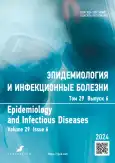History of Anthrax Study: From the Holy Scripture to the First Half of the 19th Century
- Authors: Nikiforov V.V.1,2
-
Affiliations:
- Pirogov Russian National Research Medical University
- Academy of Postgraduate Education of the Federal Research and Clinical Center of Specialized Medical Care and Medical Technologies
- Issue: Vol 29, No 6 (2024)
- Pages: 444-454
- Section: Historical Articles
- Submitted: 04.02.2025
- Accepted: 10.02.2025
- Published: 08.04.2025
- URL: https://rjeid.com/1560-9529/article/view/653451
- DOI: https://doi.org/10.17816/EID653451
- EDN: https://elibrary.ru/QRBVOS
- ID: 653451
Cite item
Abstract
Anthrax (also known as Siberian plague) has been known for a very long time and was recognized as a distinct nosological entity many centuries ago, long before the discovery of the causative pathogen responsible for the disease. Today, anthrax is one of the most thoroughly studied infectious diseases. This makes the analysis of historical religious sources (such as the Holy Scriptures and the Torah) and literary works (including Virgil’s “Georgics”, Ovid’s “Metamorphoses”, and a compilation of ancient Greek medical texts “Hippiatrica”) especially interesting, as these texts directly or indirectly describe the devastation caused by anthrax. For example, the fifth, sixth, and tenth plagues of Egypt are often interpreted as referring specifically to anthrax, while the remaining plagues are thought to create conditions conducive to epizootics and epidemics. The spread of the infection across Europe and Asia is well-documented, including references to anthrax outbreaks among animals in Venice in 1598, large-scale epidemics in Germany, Hungary, and Poland between 1709 and 1714, and the extensive circulation of the disease in the early 19th century in Russia, the Netherlands, and England. Anthrax was first introduced to the Americas in Louisiana by French settlers, during the early 1700s. In Rus’, this long-known infection was referred to by a variety of local and regional names, including postrel (from “to shoot” or “to strike suddenly” possibly referring to the sudden onset of the disease), snake postrel (referring to the fulminant form), and fiery vered or ognevik (referring to the carbuncular form). The term Siberian plague first appeared in Russian medical literature in the 1780s, thanks to the dedicated work of S. S. Andreevsky (1760–1818), including his reports “On Siberian Plague” submitted to the Medical Board of the Russian Empire in 1778 and 1789.
Full Text
About the authors
Vladimir V. Nikiforov
Pirogov Russian National Research Medical University; Academy of Postgraduate Education of the Federal Research and Clinical Center of Specialized Medical Care and Medical Technologies
Author for correspondence.
Email: v.v.nikiforov@gmail.com
ORCID iD: 0000-0002-2205-9674
SPIN-code: 9044-5289
MD, Dr. Sci. (Medicine), Professor
Russian Federation, Moscow; MoscowReferences
- Klemm DM, Klemm WR. A history of anthrax. J Am Vet Med Assoc. 1959;135:458–462.
- Wells HG. The outline of history. Garden City Books, Garden City, NY; 1949. Р. 102, 162, 237.
- Blanc HW. Anthrax: The disease of the Egyptian plagues. New Orleans Med Surg J. 1890;18:1–25.
- Bochart S. Hierozoicon sive bipartitum opus de animalibus scripturae (3:575, 2:572). London: Roycroft; 1663. In: Noscemus Wiki. Hierozoicon. Available from: http://wiki.uibk.ac.at/noscemus/Hierozoicon (last revision: 21.02.2022). Accessed: Nov 11, 2024.
- Torah. Pentateuch and Haftarot (Hebrew text with Russian translation and classical commentary `Soncino’. Commentary by Dr J. Hertz, Chief Rabbi of the British Empire). Transl. of the commentary by Z. Meshkov, edited by Dr M. Grunberz. Gesharim; 1999. 1456 р.
- Cherkasky BL. Epidemiology and prevention of anthrax. Moscow: Intersen; 2002. 384 р. (In Russ.)
- Stein CD. Anthrax. In: Diseases transmitted from animals to man. 4th ed. Hull TG, editor. Springfield, Ill., Thomas; 1955. Р. 65–108.
- Smithcors JF. Evolution of the veterinary art. Veterinary Medicine Publishing Co., Kansas City, Mo.; 1957. Р. 21–172.
- Burgasov PN, Rozhkov GI. Sybireasal infection. Moscow: Medicine; 1984. 212 р. (In Russ.)
- Supotnitsky MV. Biological warfare. Introduction to epidemiology of artificial epidemic processes and biological lesions: a monograph. Moscow: Chair:Russian Panorama; 2013. 1136 р. (In Russ.)
- Gannushkin MS. General epizootology. 2nd ed., supplement. and revision. Moscow: Selkhozgiz, 1948 (printing house ‘Krasnyi proletarii’). 352 p. (Series: Textbooks and teaching aids for higher agricultural educational institutions). (In Russ.)
- Ebedes H. A new look at anthrax. In: Proceedings of the 4th International Conference of the Wildlife Disease Association, Sydney, August 25–28. Sydney, Australia; 1981. P. 85–87.
- Turnbull PC, Shadomy SV. Anthrax from 5000 BC to AD 2010. In: Bacillus anthracis and anthrax. Bergman NH, editor. Hoboken: John Wiley & Sons; 2011. doi: 10.1002/9780470891193.ch1 EDN: YBSAJW
- Blancou J. Fievre charbonneuse. In: Histoire de ta surveillance et du contrale des maladies animates trans-missibtes. Paris: Office International des Epizooties; 2000. P. 83–109.
- Morens DM, Littman RL. Epidemiology of the plague of Athens. Transactions American Philological Association. 1992;122:271–304. doi: 10.2307/284374
- Dirckx JH. Virgil on anthrax. Am J Dermatopathol. 1981;3(2):191–195. doi: 10.1097/00000372-198100320-00012
- Dong SL. Progress in the control and research of anthrax in China. Salisbury Med Bull Suppl. 1990;68:104–105.
- Salmon DE. Anthrax. In: Special report on diseases of the horse. Salmon DE, Law J, Liautard А, et al, editors. Washington, DC: Government Printing Office; 1896. Р. 526–530.
- Koch R. Die Aetiologie der milzbrand-krankheit, begrundet auf die entwicklungsgeschichte des bacillus anthracis. Beitragezur Biologie Pflanzen. 1876;2(2):277–310.
- Higgins CH. Anthrax. Bull. 23. Ottawa, Department of Agriculture, Health of Animals Branch; 1916. P. 3–8.
- Morens DM. Epidemic anthrax in the eighteenth century, the Americas. Emerg Infect Dis. 2002;8(10):1160–1162. doi: 10.3201/eid0810.020173
- Hanson RP. The earliest account of anthrax in man and animals in North America. J Am Vet Med Assoc. 1959;135:463–465.
- Purdom PW. Anthrax studies in Philadelphia. In: Proceedings of the Symposium on Anthrax in Man, October 8, 1954. University of Pennsylvania; 1954. P. 24–44.
- Brachman PS. Human anthrax in the United States. Antimicrob Agents Chemother (Bethesda). 1965;5:111–114. doi: 10.1128/AAC.5.2.111
Supplementary files






